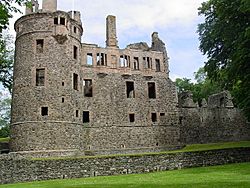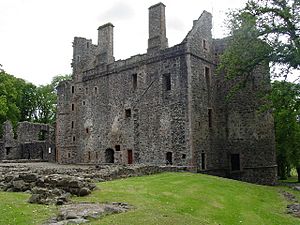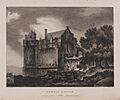Huntly Castle facts for kids
Quick facts for kids Huntly Castle |
|
|---|---|
| Huntly, Aberdeenshire | |

Huntly Castle
|
|
| Coordinates | 57°27′18″N 2°46′52″W / 57.45488°N 2.78117°W |
| Type | L-plan tower house |
| Site information | |
| Controlled by | Strathbogie family (1100-1314) Clan Gordon (1314- ) |
| Site history | |
| Built | 12th century |
| Built by | Duncan II, Earl of Fife |
| Events | |
| Official name | Huntly Castle |
| Type | Secular: bridge; castle; motte; well |
| Designated | 31 December 1921 |
| Reference no. | SM90165 |
Huntly Castle is a ruined castle located north of the town of Huntly in Aberdeenshire, Scotland. It stands where the Deveron and Bogie rivers meet. For centuries, it was the home of the chief of Clan Gordon, one of Scotland's most powerful families.
Over the years, four different castles have been built on this site. They have been known by names like Huntly Castle, Strathbogie Castle, or the Peel of Strathbogie.
Contents
Location and Early Buildings
Huntly Castle is strategically placed where two rivers, the Deveron and the Bogie, join. The very first castle, built around 1180, was a wooden fort on top of a large earthen mound called a motte. This design gave defenders a good view of the surrounding area.
Later, a stronger stone castle was built nearby. The grand castle we see the ruins of today was built at the southern end of the property.
History of the Castle
The first castle was built by Duncan II, Earl of Fife, and it was called the Peel of Strathbogie. His family, the Strathbogies, lived there for over a century. They were once loyal to the famous Scottish king, Robert the Bruce. When the king fell ill, he even stayed at the castle to recover.
However, in 1314, just before the important Battle of Bannockburn, David of Strathbogie switched his loyalty to the English. After winning the battle, Robert the Bruce saw this as a betrayal. He gave the castle and lands to one of his most loyal supporters, Sir Adam Gordon of Huntly. The Gordon family would control the castle for hundreds of years. In 1506, the castle was officially renamed Huntly Castle.
A Royal Favorite
The Gordons built a much grander castle on the site. It became so impressive that it attracted royal visitors. King James IV of Scotland came to Huntly several times in the early 1500s. He enjoyed watching the stonemasons work on the new building and even gave them tips.
During his visits, the king participated in shooting contests and played cards. He was often accompanied by his musicians, including an African drummer. These visits were part of the king's yearly trip, or pilgrimage, to a famous shrine.
The castle was built in an L-shape and had a five-story tower. It was decorated with ornate stonework on the outside and inside, some of which can still be seen today.
Mary, Queen of Scots and the Castle
During the 1500s, the castle was at the center of drama involving Mary, Queen of Scots. The Earl of Huntly was one of the most powerful men in the north of Scotland. In 1562, the queen decided he had become too powerful.
She sent her soldiers to seize the castle. The Earl of Huntly managed to escape just in time, running out the back without his boots and finding a horse. His wife, Countess Elizabeth Keith, welcomed the queen's men, gave them a meal, and showed them around the castle.
Later, the Earl of Huntly fought against the queen's army at the Battle of Corrichie and died. The castle was then taken over by the queen's soldiers. Many of its valuable furnishings, including 45 tapestries, were packed up and sent to the queen's royal collection in Edinburgh.
The Fatal Football Match
A strange and sad event happened in 1576. The fifth Earl of Huntly, a healthy man, had been out hunting. After returning to the castle and having dinner, he went to play football on the green outside. Suddenly, he collapsed.
He was carried to his bedchamber in the castle's round tower, but he died soon after. After his death, some spooky events were said to have happened. Servants in other parts of the castle suddenly fainted. Unexplained noises were heard in the room where the Earl's body had been prepared for burial. These stories, whether true or not, show how important and mysterious the castle seemed to people at the time.
A King's Anger
In the late 1500s, the Earl of Huntly was a Catholic, which put him in conflict with the Protestant king, James VI. In 1589, the king marched to Huntly with an army and 100 workers, planning to demolish the castle. The Earl fled and emptied the castle of its furniture. At the last minute, he surrendered and begged the king to spare his home.
The trouble wasn't over. After another conflict, the king returned in 1594 with his master of works, William Schaw. They planned to use gunpowder to blow up the main tower. However, some of the king's advisors argued that the castle should be saved to house royal soldiers. In the end, the castle was only partially damaged, not completely destroyed.
The Final Grand Additions
The Earl of Huntly, who later became a Marquess, repaired and expanded the castle. He added a beautiful new front to the main building, carved with his name, George Gordon, and his wife's name, Henrietta Stewart.
The castle saw more conflict during the Civil Wars of the 1640s. It was captured by different armies. In 1647, it was defended by Lord Charles Gordon, but his soldiers were forced to surrender. The Marquess of Huntly himself was captured and held prisoner in his own home before being taken to Edinburgh for his execution.
King Charles II visited briefly in 1650. But the wars marked the end of the Gordon family's time living at Huntly Castle.
From Ruin to Landmark
By the 1700s, the castle was falling into decay. Local people began taking its stones to build their own houses. During the Jacobite Rising of 1745, it was used by government soldiers.
For many years, the castle was just a ruin. But in the 19th century, people began to appreciate its history and beauty. The Gordon family owned the castle until 1923.
Today, Huntly Castle is cared for by Historic Environment Scotland. It is protected as a scheduled monument, meaning it is a nationally important historical site that people can visit and enjoy.
Images for kids
See also
 In Spanish: Castillo de Huntly para niños
In Spanish: Castillo de Huntly para niños




